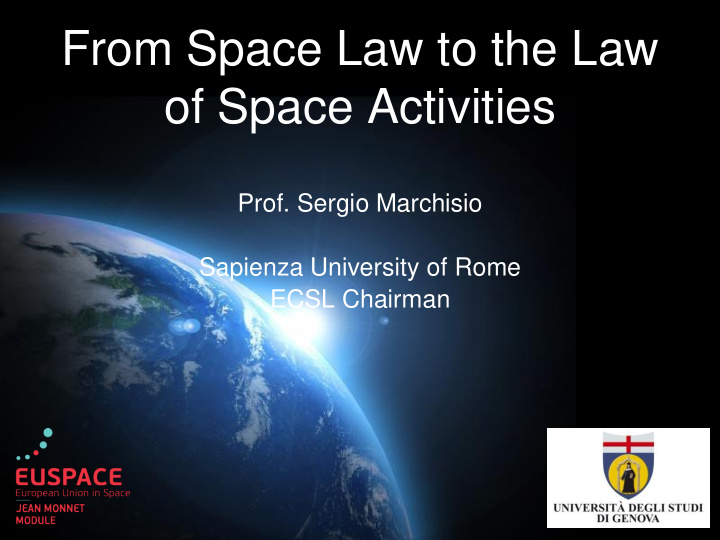



From Space Law to the Law of Space Activities Prof. Sergio Marchisio Sapienza University of Rome ECSL Chairman 1
Introduction: Making Space for Private Actors ASIL 2017 Is there a coherent set of rules to govern outer space? Is the OST still valid? Private perspectives Potentially harmufl Interferences Revision or what? 2
Law governing outer space activities: basic elements Definition of space law Notion based on the content of the rules Rules belonging to different legal systems (international law/national legislation) and different branches of law (public law/private law). Definition of space law based on its object: the regulation of space activities . Multidisciplinary perspective. 3
Relationship between aspects of public and private law Public Law nature of the legal framework on space activities Safeguarding the interests of the State (national security, defense and so on) Commercialization of space activities Role of private and commercial law Distinction public / private law to identify groups of norms and determine the legal regimes applicable to different aspects of the same space activity. 4
Space Law Art. VI, Outer Space Treaty, 1967 States responsible for their national activities in outer space Responsibility whether such activities are carried on by governmental agencies or by private entities Activities of non-governmental entities in outer space subject to authorization and continuing supervision by the appropriate State . Equivalence public / private activities for the purposes of State responsibility for national activities in space as an exception to the principles of international law. 5
Main commercialized space applications New commercialization phase of space activities US liberalisation of the satellite communication market Privatization of intergovernmental satellite organizations: INTELSAT, Inmarsat, Eutelsat New applications with high socio-economic impact in the field of Earth observation, satellite navigation and the transition to Information Society 6
Legal challenges of new sectors Structural changes in the space industry Traditional industry companies focused on well-established lines of business, in partnership with Governments, in sectors with high value, low volume of sales, and declining growth. New ventures flexible organization focused on new technologies, innovative and taking risks. New programs of launches to ensure easier access to space through the reduction of costs (democratization of space) 7
Air and space law Comparative perspective Air law – Law-making within the framework of ICAO through technical norms adopted by opting out procedures. Space law - United Nations Committee on the Peaceful Uses of Outer Space (COPUOS) without normative power. Legal regime of air and outer space Every State has complete and exclusive sovereignty over the air-space above its territory. Outer space: regime of free access, exploration and use. Exploration and use of space qualified as province of all mankind res communis omnium No boundary legally established between the two areas 8
New space race S pace tourism hybrid features Sub-orbital flights Need for an ad hoc regulation Commercial Launch Amendment Act , US, 2004 9
International rules governing space activities Treaties Property rights over natural resources of celestial bodies Hague WG on Space Resources Building Blocks International cooperation for the benefit of mankind Private Law Instruments: Toward a Trivialization ? 10
Recommend
More recommend